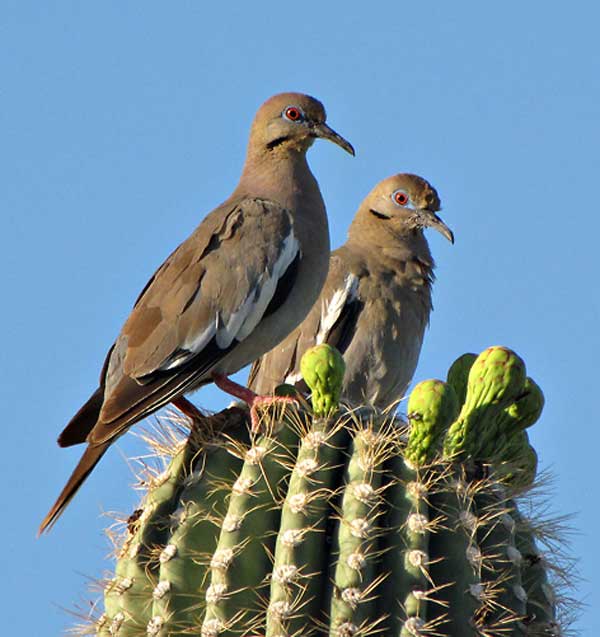
Zenaida asiatica (*)
Superregnum: Eukaryota
Regnum: Animalia
Subregnum: Eumetazoa
Cladus: Bilateria
Cladus: Nephrozoa
Superphylum: Deuterostomia
Phylum: Chordata
Subphylum: Vertebrata
Infraphylum: Gnathostomata
Megaclassis: Osteichthyes
Cladus: Sarcopterygii
Cladus: Rhipidistia
Cladus: Tetrapodomorpha
Cladus: Eotetrapodiformes
Cladus: Elpistostegalia
Superclassis: Tetrapoda
Cladus: Reptiliomorpha
Cladus: Amniota
Classis: Reptilia
Cladus: Eureptilia
Cladus: Romeriida
Subclassis: Diapsida
Cladus: Sauria
Infraclassis: Archosauromorpha
Cladus: Crurotarsi
Divisio: Archosauria
Cladus: Avemetatarsalia
Cladus: Ornithodira
Subtaxon: Dinosauromorpha
Cladus: Dinosauriformes
Cladus: Dracohors
Cladus: Dinosauria
Ordo: Saurischia
Cladus: Eusaurischia
Cladus: Theropoda
Cladus: Neotheropoda
Cladus: Averostra
Cladus: Tetanurae
Cladus: Avetheropoda
Cladus: Coelurosauria
Cladus: Tyrannoraptora
Cladus: Maniraptoromorpha
Cladus: Maniraptoriformes
Cladus: Maniraptora
Cladus: Pennaraptora
Cladus: Paraves
Cladus: Eumaniraptora
Cladus: Avialae
Infraclassis: Aves
Cladus: Euavialae
Cladus: Avebrevicauda
Cladus: Pygostylia
Cladus: Ornithothoraces
Cladus: Euornithes
Cladus: Ornithuromorpha
Cladus: Ornithurae
Cladus: Carinatae
Parvclassis: Neornithes
Cohors: Neognathae
Cladus: Neoaves
Cladus: Columbimorphae
Ordo: Columbiformes
Familia: Columbidae
Subfamilia: Columbinae
Genus: Zenaida
Species: Zenaida asiatica
Subspecies: Z. a. asiatica – Z. a. australis – Z. a. mearnsi
Name
Zenaida asiatica (Linnaeus, 1758)
Synonyms
Columba asiatica (protonym)
References
Linnaeus, C. 1758. Systema Naturae per regna tria naturae, secundum classes, ordines, genera, species, cum characteribus, differentiis, synonymis, locis. Editio Decima, Reformata. Tomus I. Holmiæ (Stockholm): impensis direct. Laurentii Salvii. 824 pp. DOI: 10.5962/bhl.title.542 [first availability: page 163] BHL Reference page.
Vernacular names
català: Tórtora d'ales blanques
čeština: Hrdlička bělavokřídlá
dansk: Hvidvingedue
Deutsch: Weißflügeltaube
English: White-winged Dove
Esperanto: Blankflugila turto
español: Zenaida Aliblanca
suomi: Pilkkasiipikyyhky
français: Tourterelle à ailes blanches
italiano: Tortora alibianche
日本語: ハジロバト
Nederlands: Witvleugeltreurduif
norsk: Hvitvingedue
polski: gołębiak białoskrzydły
português: Rolinha-comum-da-ásia
Runa Simi: Kukuli
русский: Белокрылая горлица
slovenčina: Nachovka bielokrídla
svenska: Vitvingad duva
中文: 白翅哀鸽
The White-winged Dove (Zenaida asiatica) is a dove whose native range extends from the south-western USA through Mexico, Central America, and the Caribbean. It has also been introduced to Florida.
The White-winged Dove is expanding outside of its historic range into Kansas, Arkansas, Oklahoma, and northern New Mexico. Unlike most of the White-winged Doves in Texas, the doves in these regions do not migrate in winter.
The rock singer Stevie Nicks, a native of Arizona, where the bird is most common in the USA, mentions the White-winged Dove and its call prominently in her 1981 hit "Edge of Seventeen".
Description
White-winged Doves are large, chunky pigeons at 29 cm. They are brownish-gray above and gray below, with a bold white wing patch that appears as a brilliant white crescent in flight and is also visible at rest. Adults have a patch of blue, featherless skin around each eye and a long, dark mark on the lower face. Their eyes, legs, and feet are red.
The sexes are similar, but juveniles are grayer than adults. They have no blue eye ring and their legs and feet are brownish pink.
The cooing calls are who-cooks-for-you and hoo hoo hoo.
Ecology
Most populations of White-winged Doves are migratory, wintering in Mexico and Central America. The White-winged Dove inhabits scrub, woodlands, desert, and cultivated areas. It builds a flimsy stick nest in a tree and lays two cream-colored to white, unmarked eggs. Its flight is fast and direct, with the regular beats and occasional sharp flick of the wings that are characteristic of pigeons in general.
White-winged Doves feed on a variety of seeds, grains, and fruits. Western White-winged Doves (Zenaida asiatica mearnsii) migrate into the Sonoran Desert to breed during the hottest time of the year because they feed on pollen and nectar, and later on the fruits and seeds of the Saguaro cactus. This gregarious species can be an agricultural pest, descending on grain crops in large flocks. It is also a popular gamebird in areas of high population.
References
* BirdLife International (2004). Zenaida asiatica. 2006 IUCN Red List of Threatened Species. IUCN 2006. Retrieved on 9 May 2006. Database entry includes justification for why this species is of least concern.
* "National Geographic" Field Guide to the Birds of North America ISBN 0-7922-6877-6
* Handbook of the Birds of the World Vol 4, Josep del Hoyo editor, ISBN 84-87334-22-9
* "National Audubon Society" The Sibley Guide to Birds, by David Allen Sibley, ISBN 0-679-45122-6
Retrieved from "http://en.wikipedia.org/"
All text is available under the terms of the GNU Free Documentation License

